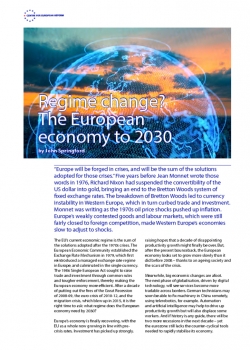
Regime change? The European economy to 2030
The crises of the 1970s led to the single currency and a deeply integrated single market. What economic regime will the EU need to build after the crises of the last decade?
“Europe will be forged in crises, and will be the sum of the solutions adopted for those crises.” Five years before Jean Monnet wrote those words in 1976, Richard Nixon had suspended the convertibility of the US dollar into gold, bringing an end to the Bretton Woods system of fixed exchange rates. The breakdown of Bretton Woods led to currency instability in Western Europe, which in turn curbed trade and investment. Monnet was writing as the 1970s oil price shocks pushed up inflation. Europe’s weakly contested goods and labour markets, which were still fairly closed to foreign competition, made Western Europe’s economies slow to adjust to shocks.
The EU’s current economic regime is the sum of the solutions adopted after the 1970s crises. The European Economic Community established the Exchange Rate Mechanism in 1979, which first reintroduced a managed exchange rate regime in Europe, and culminated in the single currency. The 1986 Single European Act sought to raise trade and investment through common rules and tougher enforcement, thereby making the European economy more efficient. After a decade of putting out the fires of the Great Recession of 2008-09, the euro crisis of 2010-12, and the migration crisis, which blew up in 2015, it is the right time to ask: what regime does the European economy need by 2030?
The EU’s current economic regime is the sum of the solutions adopted after the 1970s crises.
Europe’s economy is finally recovering, with the EU as a whole now growing in line with pre-crisis rates. Investment has picked up strongly, raising hopes that a decade of disappointing productivity growth might finally be over. But, after the present bounceback, the European economy looks set to grow more slowly than it did before 2008 – thanks to an ageing society and the scars of the crisis.
Meanwhile, big economic changes are afoot. The next phase of globalisation, driven by digital technology, will see services become more tradable across borders. German technicians may soon be able to fix machinery in China remotely, using telerobotics, for example. Automation and artificial intelligence may help to drive up productivity growth but will also displace some workers. And if history is any guide, there will be two more recessions in the next decade – yet the eurozone still lacks the counter-cyclical tools needed to rapidly stabilise its economy.
The movement of people within the Union is lessening, but young, skilled workers migrating towards the core of the EU economy have implications both for economic convergence and for the sustainability of welfare states in the member-states they leave. Meanwhile, immigration into Europe looks set to continue at a high rate, and may accelerate: the bulge of young people in Africa and the Middle East is much larger than that of Latin America in the 1970s, 80s and 90s. The latter led to faster rates of immigration to the United States and contributed to the radicalisation of the Republican party.
All of these trends have implications for European growth as a whole; whether poorer countries can continue to catch up with richer ones; and whether the European project will survive politically. Unlike in the 1970s, solutions to the EU’s current problems require the Union to get involved in distribution – of the costs and benefits of technological change; of the burden of adjustment to recessions; and of migrants from outside the EU between member-states.
Unlike the 1970s, solutions to the EU’s current problems require the Union to get involved in distribution of costs and benefits.
Technological change – and continued offshoring – will make it harder for poorer EU countries to pursue an export-based industrial growth model. The proportion of European workers employed in industrial jobs has fallen, even though industrial output has risen. The EU will continue to use competition policy and create standards and regulations to try to stop digital monopolies from damaging consumer interests. But it could also do more to prevent most of the production of new digital technology from taking place in the US and China. More EU and national funds could be spent on science and the development and dissemination of new technologies across the economy, rather than on physical infrastructure and farm subsidies. EU funding should be awarded to the institutions and companies most able to use it effectively, which will probably be in richer member-states, raising questions about the industrial strategies that poorer member-states can pursue.
The eurozone has created so much tension since 2010 because the member-states had to decide who paid for the debts incurred in the run-up to 2008. Such distributional issues have historically been the preserve of nation-states, in which democratic politics could determine the winners and losers. The eurozone crisis led to bail-outs of both the European banking sector and the Greek state, and the European Central Bank has succeeded in lowering interest rates in southern Europe through the Outright Monetary Transactions programme (by which the ECB promised to buy the sovereign debt of a member-state on the brink of default) and quantitative easing (whereby the ECB buys up the sovereign debt of all member-states in exchange for newly created money). But debtors have not been allowed to default. Such heavy debt burdens are manageable now, but the ECB may not be able to keep sovereign borrowing costs down in future recessions. If the euro area countries cannot agree to a deposit insurance scheme and a meaningful resolution fund for banks in distress, member-states risk being dragged down by failed banks based in their jurisdiction. So far, Germany, the Netherlands, Austria and other countries have successfully stymied attempts to share the costs of recessions more evenly between creditors and debtors. The two recessions due between now and 2030 may force the issue.
The politics of ageing, slow-growing societies also tend to be dominated by distributional issues. This is a particular concern for countries such as Germany, Italy and some Central and Eastern European states, which have low birth rates or high rates of emigration. For poorer member-states, the continued loss of young skilled workers will slow their rate of convergence with rich ones.
Disorderly migration across the external border of Schengen has led to rising support for nativist, anti-EU parties, largely because of distributional issues: Italy and Greece sought solidarity from other member-states, but Poland, Hungary, the Czech Republic and many others have taken in very few asylum-seekers from Greece and Italy. In the long-run, the pressure to co-ordinate member-states’ migration and asylum regimes more closely is likely to increase. Migrants and refugees granted citizenship in one EU country have the right to move to others; and migration to the EU is likely to rise, not fall.
Over the next two years, the CER will be conducting a research programme on the European economy to 2030.
Over the next two years, the CER will be conducting a research programme on the European economy to 2030, which will be run from our new Berlin office. By focusing on the long-run trends that will shape the European economy, we hope to provide a strategy for European policy-makers, who have spent the last decade fighting crises. It seems likely that the EU will have to become less technocratic, and while the EU will continue to focus on efficiency, institutions and rules will be needed that allow it to distribute the costs and benefits of economic change in a way that national publics consider to be fair. That will not be an easy task, but we will try to offer some guidance.
John Springford is deputy director of the Centre for European reform.

